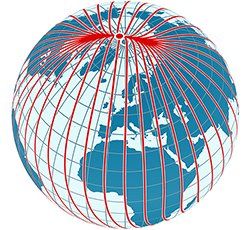Researchers reveal the secret of east-west navigation in birds
Genuine natural patent: migratory birds solve one of the most difficult navigation problems in an astonishingly refined way, as an experiment with reed warblers reveals. For they recognize their east-west position at the magnetic declination - the deviation between the magnetic and geographic North Pole. This is made possible by the birds comparing the information of their magnetic compass with location information from the starry sky and the sun.

The reed warbler can determine its longitude position by means of the magnetic declination - which is surprisingly precise. © Matthias Barby/CC-by-sa 3.0Sailors took centuries to solve this problem: determining the degree of longitude. While the latitude can be read at the height of the stars above the horizon, the position determination in East-West direction requires more complex calculations - and an accurate time measurement. However, this was only possible for seafarers when the British watchmaker John Harrison in 1753 invented the first full-scale ship chronometer.
How do the migratory birds manage this?
But there are other creatures that have been around half the world for thousands of years: migratory birds. Some of them regularly fly the Atlantic, while others fly 14,500 kilometers from Alaska to Bering Strait and Asia to Africa every year. The birds navigate mainly by means of their magnetic compass, but also by the sun and the stars.
These navigational aids, however, do not explain how migratory birds solve the longitude problem: how do they manage to remain faithful to their routes in the east-west direction?
Birds have no sense of time differences, explain Nikita Chernetsov from the Russian Academy of Sciences and his colleagues. So they have to solve this problem in a different way, but how has been a scientific puzzle.
Factitious change of location

Declination: The angle of the magnetic field lines differs depending on the east-west position to varying degrees from the geographic lengths. © Sch/CC-by-sa 4.0Their assumption: Perhaps the birds can sense the magnetic declination - the angle at which the magnetic field lines deviate from the direction to the geographic north pole. If this were the case, then a slight angular change of the artificial magnetic field would have to confuse the position determination of the reed warblers.
Direction is adjusted
And in fact, if the magnetic field remained unmanipulated, the reed warbler fluttered in the direction of the West-South West - their typical flight route. But when the researchers turned the magnetic field by 8.5 degrees counter-clockwise, the behavior of the birds changed drastically: they changed their flight direction by 151 degrees and flitted to East-South East.
The reason: the slight displacement of the magnetic field lines corresponded to a displacement of about 1,200 kilometers to the west. And the reed warblers had obviously recognized this by their inner compass. Because in Europe, the declination angle changes very regularly from east to west. Instead of in Russia, the birds now believed to be in Scotland and redirected their flight route accordingly, as the researchers explain.
Sense for magnetic declination
These results suggest that reed warblers can recognize the magnetic declination and use it to determine their East-West position within Europe, Chernetsov and colleagues said. Since all other magnetic and other stimuli have remained constant during the test, the birds must be able to determine their position by comparing the compass data with the sky information.
And this is astonishingly accurate: Apparently, the reed warblers can even recognize angular deviations of one degree and less.
For the first time, we are giving an answer to the question of how birds determine their East-West position, says Henrik Mouritsen from the University of Oldenburg.
At least some bird species could use the magnetic declination as an indicator of the degree of latitude.
Source: Current Biology, 2017; doi: 10.1016 / j.cub.2017.07.024

SCIENCE!
Awesome post buddy, keep it up :)
Thank you! I will try my best.
@n3bul4 got you a $1.61 @minnowbooster upgoat, nice! (Image: pixabay.com)
Want a boost? Click here to read more!
This post recieved a vote from @minnowpond. For more information click https://steemit.com/steemit/@minnowpond/boost-your-rewards-with-minnowpond
This post recieved a vote from @minnowpond. For more information click https://steemit.com/steemit/@minnowpond/boost-your-rewards-with-minnowpond
This post has received a 1.04 % upvote from @drotto thanks to: @banjo.
This post has received a 6.87 % upvote from @buildawhale thanks to: @n3bul4. Send 0.100 or more SBD to @buildawhale with a post link in the memo field to bid on the next vote.
To support our curation initiative, please vote on my owner, @themarkymark, as a Steem Witness
This post has received a 1.92 % upvote from @booster thanks to: @n3bul4.